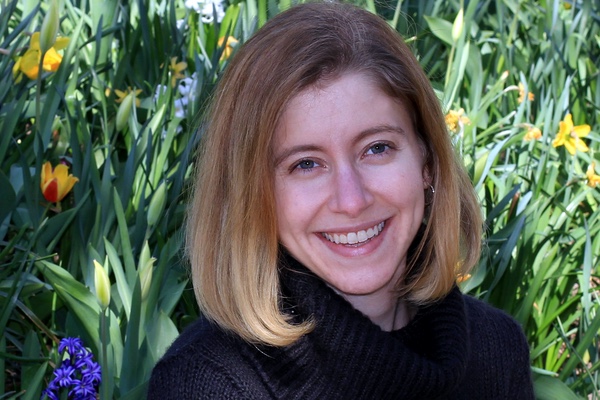Enjoy our WTP Spotlights, notable selections featuring artists
and writers from our Woven Tale Press magazine. To read the
issue in full subscribe and you can also register on our site
to enjoy our archive.
 Kelly Ann Jacobson is the author of many books, including Cairo in White, and the poetry collection I Have Conversations with You in My Dreams. She also writes young adult speculative novels under her pen name, Annabelle Jay. Her short stories have appeared in Northern Virginia Review, Iron Horse Literary Review, Best Small Fictions 2020, among others.
Kelly Ann Jacobson is the author of many books, including Cairo in White, and the poetry collection I Have Conversations with You in My Dreams. She also writes young adult speculative novels under her pen name, Annabelle Jay. Her short stories have appeared in Northern Virginia Review, Iron Horse Literary Review, Best Small Fictions 2020, among others.
Crow Summer
From WTP Vol. VIII #9
I.
THE CROW
The baby crow is a storm under a Virginia sweetspire as it struggles to move out of view. We know it is a crow because the wildlife rehabilitator asked if its eyes are blue, which they are, and if its mother is somewhere watching, which she is. In fact, she caws at us from the top of a nearby tree with extreme frequency, so that we can hardly forget her. “The bird is probably fine,” the rehabilitator told us, though the angle of its right wing against the ground, flat like a hand getting a manicure, seems nothing like the left’s fluttering form. “Baby crows learn to fly from the ground. Honestly, they are just weirdos for a while. I wouldn’t worry about it.” He paused. “But if you want to bring it in…”
We don’t. There are bugs to think about, and pecks to our hands, and the drive, which will fill our Sunday night. Instead, we watch the crow until it finds a safe haven in the bushes and then walk home.
Still, we can’t quite shake the guilt, and so we each look during our daily walks. “I think it flew away!” one of us announces Monday afternoon. “Definitely gone,” agrees another on Tuesday morning. But on Tuesday afternoon, we find a wing by the barn. Dead, dead, dead, and likely our fault.
Then on Wednesday morning, during that hour when we drink coffee in our robes and pretend to read the paper, the crow makes an appearance in each of our yards.
We know it is the same crow because it is missing its right wing. The stub oozes yellow jelly, blood, and maggots. Flies circle, land, circle. The crow does not seem bothered by the insects or the weeping wound, but rather us, its killers, who it watches with its blue eyes in a scolding stare.
Then it moves on to the next person, so that the whole morning we are calling each other, asking Did you see it yet? You haven’t heard? It’s that crow…
Ben Johnson is the last house on the crow’s visitation list. By the time the crow perches on his fence, Ben hangs from the fan in his daughter’s bedroom. Maybe he already had plans to kill himself that day. Or maybe the crow pushed him over the edge.
Either way, we still see him every once in a while, his neck bent and his head askew like a broken tulip about to tumble from its stem. Sometimes, he waves back.
II.
THE TWINS
All of the babies born in the month of July come in pairs. The doctors cannot explain how it happens. “There was only one, I swear to God,” they repeat to each other in call rooms across the state, yet despite the ultrasound pictures, in which one fetus clearly occupies the black holes of the mothers’ bodies, two identical children come out.
We are not sure what to do with these extra babies. They have no cribs purchased, no drawers of clothes prepared. Many go nameless for days. As news spreads, we discover there are shared characteristics between them—a birthmark on the right shoulder, for example, and a bald spot on the back of the head that never goes away but can, as the twins age, be covered by a careful haircut.
Eventually most parents adjust, but the psychological damage has been done. The youngest twins become moody, and they accuse their parents of constant favoritism. Stranger things happen too, like how older twins report waking up in the middle of the night to find their younger twins standing over their beds holding a variety of strange objects—lamp shades, three hole punchers, and the like.
A new crop of therapists come to town specifically to deal with the twin crisis. Tensions grow.
Then, on the morning of their eighteenth birthdays, all of the younger twins disappear.
After this mass departure, which we call The Rapture (though we have heard rumors of a large group of young adults, likely the departed, spotted in the Chihuahuan Desert), the older twins sink into their own melancholy. Missing their other halves, they tattoo birthmarks on their right shoulders and shave small bald spots on their heads. As their last desperate act, most of the older twins reenact the Dance of Zalongo and throw themselves over the edge of Thompson Cliff.
We assume this bloody stain is the end of the whole ordeal, but then over the years, the younger twins trickle back. Every few months we see one of them buying groceries or negotiating the price of a new car. Their birth marks fade; their bald spots grow in.
We are never sure, when we run into them, if they are the original or the copy.
Eventually, we stop wondering.
II.
THE TIGER
In the middle of July, a white Lincoln Town Car with tinted windows rolls down Broad Street. Talk gets around town. By the time the classic car comes to a stop in front of Margot Algada’s house, her neighbors know just who to call with a report.
“Well…” they say, and then trail into silence.
“Well what?” we ask. “Who is it?”
But this turns out to be a complicated question. Onlookers who get a glance before the tiger disappears into Margot’s house agree on only a few basic facts: Male. Six feet tall. Tiger.
“Tiger?”
“Oh yes.”
Here, the accounts divert. One neighbor claims he looks like some kind of Sherlockian detective, with a long trench coat and top hat. “I wonder what Margot did,” we muse. Then another neighbor describes the tiger as a hippie type, with flowers in his fur and a tie-dye shirt. “Some boy she met on the internet, come to whisk her away,” we project. A third neighbor is sure he is a magician, which stumps us for a while until we remember Margot has a July birthday.
We must see this tiger man for ourselves, we decide.
We congregate.
To make the group look natural, Sherry Atwood, Margot’s neighbor across the street, throws a barbecue on her front lawn. We dress up for the occasion in floral dresses and straw hats, and Sherry opens a few bottles of white wine to serve in plastic glasses. She doesn’t actually have a grill, or food, so we get drunk pretty quickly. “Don’t stare,” we remind each other. “Let’s take turns.” Then one of us pretends to talk and the other looks over her shoulder. Switch. Switch.
Hours pass this way.
Finally, when the sun starts to go down and the bugs bite our exposed ankles, the tiger emerges. He is not a detective, or a hippie, or a magician. He is a regular old tiger, wearing dad jeans and a loose polo shirt. He has gray streaks in his hair. He gives us a quick and curious glance and then drives away in the Lincoln, accompanied by soft rock at a reasonable volume.
Desperate for the scoop, we march over to Margot’s house and knock on the door. Maybe the tiger is her father. Maybe the tiger came to fix the dryer.
But Margot can’t answer, because she’s dead.
IV.
THE TAIL
By August, the unexpected is expected. Our lost loved ones become names on headstones, and then nothing at all.
Most of us cope well.
There are outliers, of course. Marge, who can’t get out of bed without her husband there to serve her breakfast. Ricky with the missing leg, who drinks outside the west side gas station. And little Bobby Bacon, who loses his mother and father to the shower murders of August 14th. They were never very good parents, letting Bobby wander wherever the wind took him, we remind each other. Maybe if they’d spent more time watching their son and less time in the shower, they wouldn’t have gotten killed.
We are kind people, so we take turns keeping Bobby in our basements and give him plenty of space. Eventually, however, he turns feral as a stray cat and makes his home in a hollow tree. When Agatha McMullin loses her kite to its branches, she and her parents are too scared of the face in the crevice to retrieve it.
That evening right before sundown, reports circle of a flying object. We take to our lawn chairs, as we have done several times since the start of what we are now calling Crow Summer, and wait. Sure enough, there is the strange object—a pink mermaid with an undulating tail—and little Bobby Bacon riding on its back.
“Good for him, getting out of here,” we say.
But we don’t mean it—not a single one of us.
Click here to read more featured work by our WTP writers.

